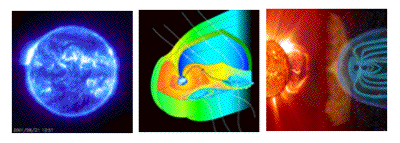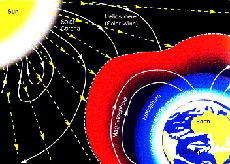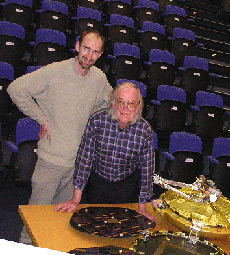

With a collection of leading speakers from some of the premier academic research centres for solar and planetary physics our teachers were treated to some outstanding talks, accompanied by inspiring video clips and images.
To begin, Dr Helen Mason (University of Cambridge) illustrated very literally the conept of 'our dynamic sun.' Helen's video clips of sun-spots revealed by a number of different instruments from the SoHo and Suntrek projects showed just how active this process appears. For more see http://sohowww.nascom.nasa.gov/

Our second speaker was Dr. Nick Achilleos (Imperial College) who has worked on both the Huygens-Cassini mission to Saturn and Venus Express. His talk was a general description of how the giant planet magnetospheres compare with the Earth, and featured some measurements from the magnetometer on Cassini (which he helped to build). Nick also included some information specifically about Venus (our nearest planetary neighbour), speaking only 2 weeks after Venus Express arrived at the planet, highlighting some of the aims for Venus Express mission.
After coffee, we were treated to a wonderful description of the Sun's influence on the Earth's outer environment covering the solar wind, magnetospheres and ionospheres by Prof. Stan Cowley, Head of the Radio and Space Plasma Physics Group at the University of Leicester, recently hailed as 'one of the outstanding scientists of his generation.'

Our final speaker was a Master Class veteran (having spoken at an earlier Master Class on Cosmology). Prof. Carl Murray (Queen Mary College) spoke about rediscovering the outer solar system describing a series projects he had led using spacecraft and ground-based results to learn more about the giant planets, their moons and rings. In true Master Class style, in which we try to highlight new developments, Carl (a member of the Cassini imaging team) spoke about how Cassini provided the first evidence for the recently announced ice plume activity on Saturn's moon Enceladus (publishedin Science only weeks earlier!).
Hands-on practical activities on solar physics are not that easy but our teachers were given 2 enlightening sessions. Firstly they heard about the Bradford Robotic Telescope and looked diectly at the website, seeing what it offered them and their students under the guidance of James Machell who runs the schools website (http://www.telescope.org). Helen Mason then returned to give some insight into school resources for teaching astronomy which she had developed in partnership with local head of Science, Mike Cripps, at Neatherd High School (see http://www.suntrek.org)
Offered as a public lecture, and attended by almost 200 people, Colin highlighted some of the challenges faced by the Beagle 2 space mission to Mars in 2003. He suggested some possible reasons for the failed mission and most interestingly was looking forward to a future landing on the Red Planet. For more information on this project see http://www.beagle2.com/index.htm

Phil pictured with Prof. Colin Pillinger and a scale model of the Mars lander